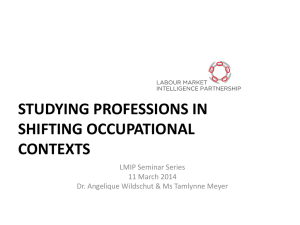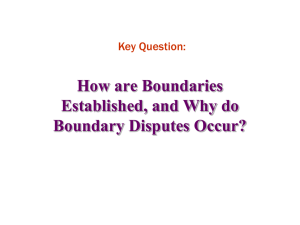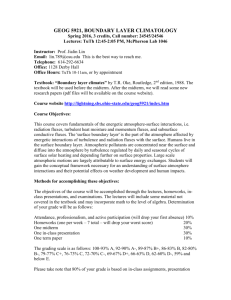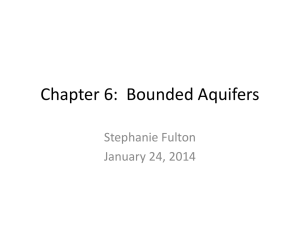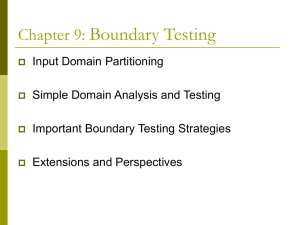Professional Boundary
advertisement
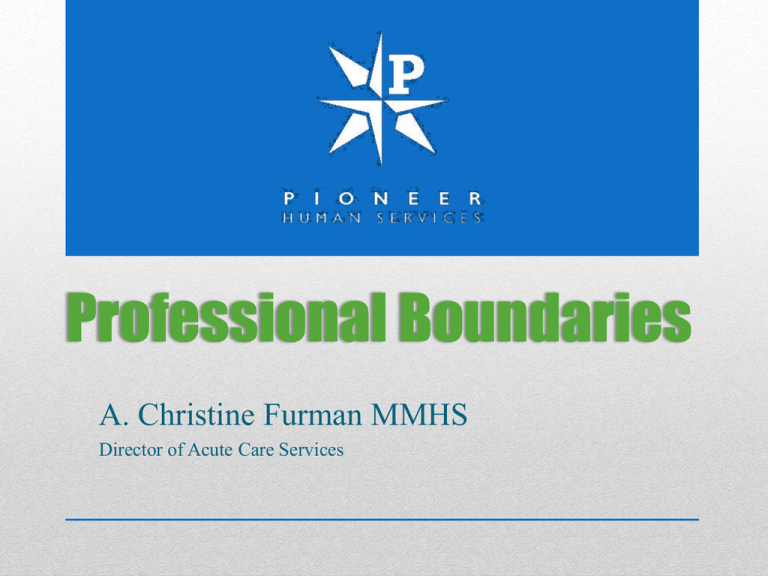
Professional Boundaries A. Christine Furman MMHS Director of Acute Care Services Agenda • Introductions • Expectations • Definition of Boundaries • Scope of Job – Scope of Treatment • Boundary Transgressions • Gray Areas • Professional Ethics • Self-Awareness Warning Signs • Prevention and Avoidance of Sexual Misconduct • Questions to ask yourself as you assess your Boundaries Purpose The purpose of this training is to help define professional boundaries, clarify professional ethical expectations and address potential boundary problems. Objective As a result of this training, participates will be able to: • Have a clearer idea of where your boundaries are. • Have the ability to better recognize boundary issues as they arise. • Clarified ethical expectations • Have a plan of action if boundaries are in danger of becoming unprofessional and unsafe. Definitions Boundary: Something that indicates a border, or a limit. Professional Boundary: The framework that we operate within that makes our work relationships professional, safe, and set the limits for the services we deliver. Professional Ethics: Standards that govern the conduct of a person operating within a certain profession. Boundary Transgressions Context – not content – often determined the appropriate boundary Physical boundary transgressions Psychological/Emotional boundary transgressions Sexual boundary transgressions Spiritual boundary transgression The Gray Areas Many boundary issues are not clear-cut or clearly defined. These are potential problem areas that we need to pay close attention to. 1. Self disclosure 2. Gift giving and receiving 3. Dual relationships 4. Friendship/over familiarity 5. Maintaining the usual 6. Physical contact Continued…. The Gray Areas, cont. 7. Personal Gain 8. Trust 9. Attraction 10. Humor 11. Secrets Remember to maintain your focus on the scope of your job. Be aware when you enter into gray areas. Be sure your communication, both verbal and written, are clear if you are concerned there has been a boundary transgression. Examples…. • She allegedly failed to show for her shift at work, and tested positive for amphetamine and methamphetamine during a urinalysis. • Unprofessional conduct for failing to comply with terms and conditions set against her registration. • Chemical Dependency Professional Program denied the application of chemical dependency professional applicant, unable to practice with reasonable skill and safety. • She was convicted of identity theft, and theft. • She was charged with unprofessional conduct. She allegedly entered into personal relationships with two clients, accepted gifts from the patients, was named a personal representative in a patient’s will, and entered into a payment scheme with a patient. • He was convicted of driving under the influence, and destruction, alteration, or concealment of evidence. Professional Ethics - NAADAC • The Counseling Relationship • Client Welfare is the primary objective • Preventing Harm, fostering benefit • Scope of Competency • Confidentiality • Professional Responsibility • Counselor Attributes • Legal and Ethical Standards Warning Signs that my Boundaries May be at Risk • I frequently think of this client when I am away from work. • I spend time with this client outside of work or my work area. • I share personal information with this client. • I have unnecessary or out of proportion concern for this client. • I am defensive of the client or my interaction with the client. • I advocate for this client more than my other clients. • This client could hurt my feelings. Continued…. Warning Signs that my Boundaries May be at Risk, cont. • I am flirtatious or have overt sexual content in my interactions with this client. • I understand the client better than other staff. • I can help this client better than other staff. • I touch this client more or differently than other clients. • This client can only deal with me. • This client waits for me to be available rather than deal with other staff. • I am willing to accept secrets from this client. Prevention and Avoidance of Sexual Misconduct • Respect cultural differences. • Do not use gestures, tone of voice, expressions, or any other behavior that a client could interpret as seductive, sexually demeaning, or sexually abusive. • Refrain from treating a client that you have had a previous intimate relationship with. • Do not make sexualized comment about a client’s body or clothing. • Do not make sexualized or sexually demeaning comments to a client. • Do not criticize sexual orientation. • Do not ask details of sexual history – unless it’s your job. Continued…. Prevention and Avoidance of Sexual Misconduct, cont. • Do not engage in inappropriate ‘affectionate’ behavior with a client. • Do not talk about your own sexual preference, fantasies, problems, etc. • Learn to detect and deflect seductive clients. • Do not request a date with a client. • Do not engage in any sexual contact. • Maintain good records that reflect any intimate questions of a sexual nature and document any and all comments or concerns made by a client relative to alleged sexual abuse, and any other unusual incident that may occur during the course of, or after an appointment. Questions to ask yourself as you Assess your Boundaries • Am I doing my job? • Am I doing what the client needs and what is in their best interest? • Whose needs are being served? • Am I treating the client differently? • How would my interactions be viewed by: My supervisor The clients family or partner My co-workers A licensing agency

